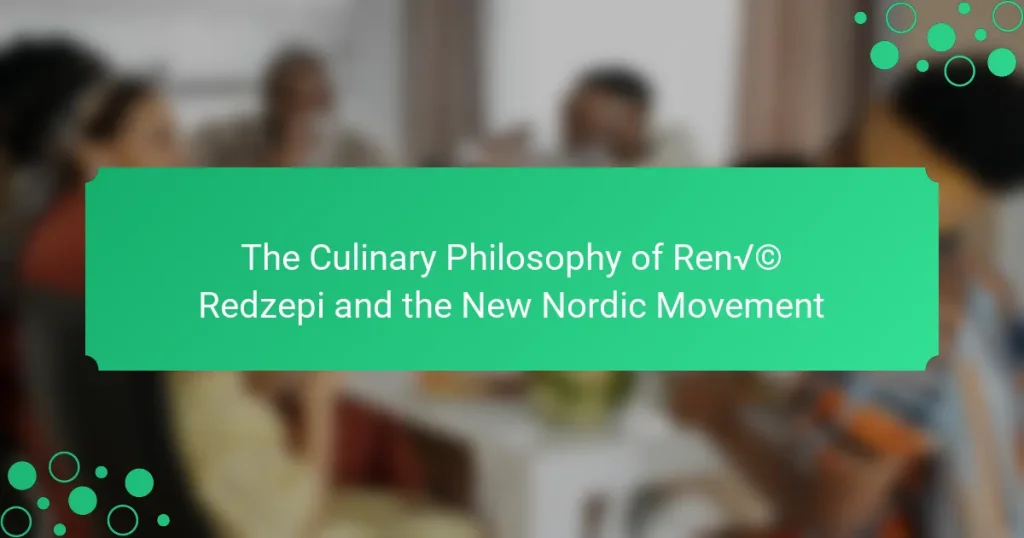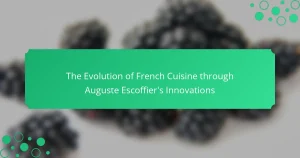
What is the Culinary Philosophy of René Redzepi and the New Nordic Movement?
The culinary philosophy of René Redzepi and the New Nordic Movement emphasizes the use of local, seasonal ingredients. This approach seeks to highlight the unique flavors and traditions of Nordic cuisine. Redzepi advocates for a deep connection to the land and its ecosystems. He promotes foraging and sustainable practices in food sourcing. The movement encourages chefs to explore and innovate with traditional techniques. It also aims to redefine Nordic identity through food. Redzepi’s restaurant, Noma, exemplifies these principles with its menu that changes with the seasons. This philosophy has influenced global culinary trends, emphasizing sustainability and locality.
How did René Redzepi influence modern culinary practices?
René Redzepi influenced modern culinary practices through his emphasis on local ingredients and innovative techniques. He pioneered the New Nordic Cuisine movement, which promotes seasonal and foraged foods. Redzepi’s approach encourages chefs to explore their regional landscapes for inspiration. His restaurant, Noma, has received multiple accolades, including the title of best restaurant in the world. This recognition has inspired chefs globally to adopt similar philosophies. Redzepi’s focus on sustainability has also shaped industry standards. He advocates for a connection between food and the environment. His influence extends beyond cooking to culinary education and food culture.
What are the core principles of Redzepi’s culinary philosophy?
René Redzepi’s culinary philosophy centers around the principles of foraging, seasonality, and a deep connection to local ingredients. He emphasizes the importance of using fresh, native produce that reflects the Nordic landscape. Redzepi advocates for creativity and innovation in cooking, encouraging chefs to experiment with flavors and techniques. Sustainability is a key aspect of his philosophy, promoting practices that respect the environment. He believes in storytelling through food, where each dish conveys a narrative of place and culture. Redzepi also values collaboration with local farmers and producers, fostering relationships that enhance the culinary experience. These principles collectively define his approach to modern Nordic cuisine.
How does the New Nordic Movement redefine traditional cooking techniques?
The New Nordic Movement redefines traditional cooking techniques by emphasizing local, seasonal ingredients and innovative preparation methods. It promotes a farm-to-table philosophy that prioritizes sustainability and freshness. Traditional techniques are adapted to highlight the natural flavors of Nordic produce. Chefs incorporate foraging and fermentation as essential practices. This movement also encourages creativity through modern presentations and techniques like sous-vide. It values simplicity and purity in flavors, contrasting with more complex traditional methods. The focus on indigenous ingredients fosters a deeper connection to the region’s culinary heritage. This approach has gained global recognition, influencing chefs worldwide.
Why is the New Nordic Movement significant in the culinary world?
The New Nordic Movement is significant in the culinary world for its emphasis on local, seasonal ingredients. It promotes a deep connection to the Nordic landscape and culture. This movement has transformed global culinary practices by prioritizing sustainability and foraging. Renowned chefs, such as René Redzepi, have popularized this approach through innovative dishes. The movement has gained international recognition, influencing fine dining worldwide. It encourages chefs to explore traditional Nordic techniques and flavors. This has led to a revival of interest in regional cuisines. The New Nordic Movement has also inspired a broader conversation about food ethics and environmental responsibility.
What impact does the New Nordic Movement have on local sourcing and sustainability?
The New Nordic Movement significantly promotes local sourcing and sustainability. This culinary philosophy emphasizes the use of locally grown and foraged ingredients. It encourages chefs to connect with local farmers and producers. This connection fosters a sustainable food system that reduces transportation emissions. The movement also highlights seasonal eating, which minimizes resource use. By prioritizing local ingredients, it supports regional economies. Research shows that restaurants adopting this philosophy often report increased customer loyalty. Overall, the New Nordic Movement advocates for a sustainable approach to food that benefits both the environment and local communities.
How does the movement promote seasonal and foraged ingredients?
The movement promotes seasonal and foraged ingredients by emphasizing local sourcing and sustainability. It encourages chefs to utilize ingredients that are in season, enhancing flavor and freshness. This approach fosters a connection between the land and the table. Chefs in the New Nordic Movement often forage for wild herbs, mushrooms, and berries. This practice showcases the region’s biodiversity and culinary heritage. By highlighting seasonal ingredients, the movement supports local farmers and ecosystems. Research shows that seasonal eating can reduce carbon footprints by minimizing transportation. The movement’s philosophy aligns with a growing trend towards sustainability in culinary practices.

What are the key attributes of René Redzepi’s culinary approach?
René Redzepi’s culinary approach is characterized by a focus on local ingredients, seasonality, and foraging. He emphasizes the use of Nordic produce, which reflects the region’s unique flora. Redzepi’s techniques often include fermentation and preservation, enhancing flavors and sustainability. His dishes are known for their artistic presentation, merging aesthetics with taste. He promotes a connection to nature, encouraging diners to appreciate the origins of their food. This philosophy has influenced the New Nordic Movement, inspiring chefs globally to prioritize local sourcing. Redzepi’s restaurant, Noma, has received multiple accolades, including the title of best restaurant in the world.
How does Redzepi incorporate Nordic culture into his dishes?
René Redzepi incorporates Nordic culture into his dishes by utilizing local ingredients and traditional cooking methods. He emphasizes foraging, sourcing wild herbs, and seasonal produce native to Scandinavia. Redzepi’s menu reflects the landscape and climate of the Nordic region. He often features dishes inspired by historical Nordic recipes. This approach connects modern cuisine with cultural heritage. Redzepi also promotes sustainability, which aligns with Nordic values of environmental stewardship. His restaurant, Noma, showcases the essence of Nordic identity through innovative presentations. The use of native flavors creates a unique dining experience that celebrates the region’s culinary history.
What unique ingredients are commonly used in his recipes?
Unique ingredients commonly used in René Redzepi’s recipes include foraged plants, wild herbs, and seasonal produce. Redzepi emphasizes the use of local ingredients to highlight Nordic flavors. Ingredients such as sea buckthorn, fermented vegetables, and wild mushrooms are frequently featured. These components reflect the New Nordic Movement’s focus on sustainability and biodiversity. His approach often incorporates traditional techniques like pickling and smoking. This culinary style showcases the unique terroir of the Nordic region. Redzepi’s recipes aim to create a deep connection between food and nature. This philosophy is evident in his acclaimed restaurant, Noma, which has received multiple accolades for its innovative use of ingredients.
How does the presentation of food reflect his philosophy?
The presentation of food by René Redzepi reflects his philosophy of simplicity and connection to nature. He emphasizes using local ingredients to create visually appealing dishes. Each plate is designed to evoke the essence of the Nordic landscape. This approach aligns with the New Nordic Movement’s focus on sustainability and seasonal produce. Redzepi often incorporates elements from nature, such as moss or stones, in his presentations. This technique enhances the dining experience by immersing guests in the environment. The aesthetic choices also reflect the cultural heritage of the region. Overall, his food presentation embodies a philosophy that values authenticity and a deep respect for nature.
What role does experimentation play in Redzepi’s cooking?
Experimentation is central to René Redzepi’s cooking philosophy. It drives innovation and creativity in his dishes. Redzepi often explores local ingredients and unconventional techniques. This approach enables him to create unique flavor profiles. For instance, he utilizes foraged ingredients, which are often unpredictable. His willingness to take risks leads to unexpected culinary outcomes. Redzepi’s experimentation reflects the principles of the New Nordic Movement. This movement emphasizes sustainability and seasonality in food. Overall, experimentation allows Redzepi to redefine modern cuisine continuously.
How does he balance innovation with tradition in his dishes?
He balances innovation with tradition in his dishes by using local ingredients and traditional techniques. René Redzepi emphasizes foraging and seasonal produce, which reflect Nordic culinary heritage. He incorporates modern cooking methods, such as fermentation and sous-vide, to enhance flavors. This approach respects traditional recipes while introducing contemporary flair. Redzepi’s commitment to sustainability also aligns with traditional practices of utilizing the entire ingredient. His dishes often tell a story, merging past and present culinary influences. By doing so, he creates a unique dining experience that honors tradition while embracing innovation.
What are some notable examples of his culinary experiments?
René Redzepi is known for his innovative culinary experiments that redefine Nordic cuisine. One notable example is his use of foraged ingredients, which emphasizes local and seasonal produce. He incorporates elements like wild herbs, moss, and seaweed into dishes. Another significant experiment is the fermentation of traditional ingredients, enhancing flavors and textures. His dish “Ants on a Log” features live ants on a branch with a creamy base, showcasing his avant-garde approach. Additionally, Redzepi has explored the concept of “nature on a plate,” presenting dishes that mimic natural landscapes. His restaurant Noma has received multiple Michelin stars, validating his experimental techniques.

How can chefs and food enthusiasts apply Redzepi’s philosophy?
Chefs and food enthusiasts can apply Redzepi’s philosophy by focusing on local, seasonal ingredients. This approach emphasizes the importance of sourcing food that is native to the region. It promotes sustainability and encourages a deep connection with the environment. Chefs can experiment with foraged ingredients to enhance their dishes. Redzepi’s philosophy also encourages creativity in presentation and flavor combinations. By embracing simplicity and authenticity, food enthusiasts can elevate their culinary experiences. This philosophy has been successfully implemented at Noma, where the menu changes with the seasons, reflecting the natural landscape.
What practical tips can be implemented in home cooking?
Use fresh, seasonal ingredients for optimal flavor. Seasonal produce is often more flavorful and nutritious. Plan meals around what is currently available in local markets. Embrace simplicity in cooking techniques to highlight ingredient quality. Techniques such as roasting or grilling can enhance natural flavors. Experiment with fermentation to add depth to dishes. Fermented ingredients, like pickles, can elevate meals with unique tastes. Incorporate foraged ingredients to connect with local ecosystems. Foraging can introduce new flavors and promote sustainability. Practice mindful cooking to foster a deeper connection with food. Mindfulness can enhance the cooking experience and appreciation for ingredients.
How can one source local and seasonal ingredients effectively?
To source local and seasonal ingredients effectively, establish connections with local farmers and producers. This approach allows access to fresh, high-quality produce. Attend farmers’ markets to discover seasonal offerings and build relationships with vendors. Research local agricultural organizations for information on seasonal crops. Utilize social media platforms to follow local farms and stay updated on their harvests. Join community-supported agriculture (CSA) programs for direct access to seasonal goods. Understanding the local climate can also inform which ingredients are available at different times of the year. Engaging with local culinary networks can provide insights into sourcing practices and seasonal trends.
What techniques can enhance creativity in the kitchen?
Techniques that can enhance creativity in the kitchen include experimenting with new ingredients, utilizing seasonal produce, and incorporating different cooking methods. Experimenting with new ingredients encourages innovation and broadens flavor profiles. Seasonal produce is often fresher and more flavorful, inspiring dishes that reflect the time of year. Different cooking methods, such as smoking, fermenting, or sous-vide, can transform familiar ingredients into unique creations. Additionally, collaborating with other chefs can introduce fresh perspectives and ideas. Keeping a cooking journal can also help track successful experiments and inspire future meals. Engaging in culinary challenges or themed cooking sessions further stimulates creativity by pushing boundaries.
What are the challenges of adopting the New Nordic Movement?
The challenges of adopting the New Nordic Movement include sourcing local ingredients, understanding seasonal cooking, and adapting traditional techniques. Sourcing local ingredients can be difficult due to climate variations and limited availability. Seasonal cooking requires a shift in mindset towards what is available at different times of the year. Adapting traditional techniques may pose a challenge for chefs accustomed to modern culinary practices. Furthermore, the movement emphasizes sustainability, which can complicate supply chains. The commitment to biodiversity and foraging can also be daunting for those unfamiliar with these practices. Lastly, there may be a lack of consumer awareness or demand for this culinary philosophy, impacting its adoption.
How can chefs overcome barriers to using foraged ingredients?
Chefs can overcome barriers to using foraged ingredients by educating themselves about local flora. Knowledge of edible plants enhances safety and culinary creativity. Networking with foragers and local experts builds valuable connections. This collaboration can provide insights into seasonal availability and sustainable practices. Additionally, chefs should experiment with foraged ingredients in small batches. This approach minimizes waste and allows for trial and error. Training staff on foraging techniques can also create a knowledgeable team. Understanding local regulations regarding foraging is essential for compliance. By addressing these areas, chefs can successfully incorporate foraged ingredients into their menus.
What strategies can be employed to educate diners about this culinary philosophy?
Engaging diners in the culinary philosophy of René Redzepi and the New Nordic Movement can be achieved through various strategies. Interactive cooking classes can immerse participants in the philosophy’s principles. These classes can highlight local ingredients and sustainable practices, essential to the movement.
Hosting tasting events allows diners to experience the unique flavors of Nordic cuisine. Each dish can be accompanied by storytelling that explains its cultural significance.
Providing educational materials, such as brochures or digital content, can reinforce the philosophy’s key concepts. Information on seasonal produce and foraging can enrich diners’ understanding.
Collaborating with local farms can create farm-to-table experiences. This connection emphasizes the importance of sourcing ingredients responsibly.
Utilizing social media platforms can also spread awareness. Sharing behind-the-scenes content, recipes, and chef interviews can engage a broader audience.
Incorporating these strategies can foster a deeper appreciation for the culinary philosophy and its values.
The main entity of the article is the culinary philosophy of René Redzepi and the New Nordic Movement. This philosophy emphasizes the use of local, seasonal ingredients, foraging, and sustainable practices, aiming to redefine Nordic cuisine and identity. The article explores Redzepi’s influence on modern culinary practices, core principles of his approach, and the significance of the New Nordic Movement in promoting sustainability and local sourcing. It also discusses how chefs and food enthusiasts can apply these principles in their cooking, the challenges of adopting this movement, and strategies for educating diners about its values.




